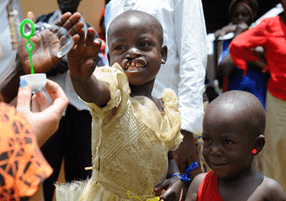
Every year, thousands of babies, children, teens and adults are affected with cleft and craniofacial conditions in the United States. According to the NCCAPM, some people are born with congenital anomalies such as cleft lip and palate while others are burned or injured in accidents, animal attacks, or are diagnosed with various oral/head/neck and skin diseases (NCCAPM). Mouthhealthy.org states that a cleft lip is a birth defect in which the upper lip remains split instead of closing together before birth and this can also happen in the roof of the mouth or the lip palate.
To raise more awareness on this cause and to improve the understanding of orofacial clefts and other conditions of the head and face, the month of July is proclaimed to be National Cleft and Craniofacial Awareness and Prevention Month. Although Cleft and craniofacial conditions are commonly associated with other countries, the conditions often occur in the United States and is one of the most common birth defects in the country. According to the Centers for Disease Control and Prevention (CDC), approximately 2,600 babies are born with a cleft palate and 4,400 babies are born with a cleft lip (with or without a cleft palate) every year in the United States (CDC, 2015). There are also other forms of craniofacial birth defects such as craniosynostosis, anotia/microtia, and anophthalmia/microphalmia.
- Craniosynostosis: Skull sutures fusing prematurely
- Anotia/Microtia: Ear is missing or is undeveloped
- Anophthalmia/Microphalmia: Missing or abnormally small eye
Throughout the month of July, the American Cleft Palate-Craniofacial Association (ACPA) and the Cleft Palate Foundation (CPF) have teamed up to promote more of an awareness about the cause and hopes that everyone will help to spread the word amongst their social media, cleft line brochures, work and public functions.
Cleft & Craniofacial Effects on Children
It is unfortunate that young children who have orofacial clefts and other craniofacial conditions have a variety of other problems as well such as difficulty eating, ear infections, misaligned teeth, and speech difficulties. As a result, these children have an increased risk of impaired language development, hearing issues and problems with their teeth.
Improving the health of children with orofacial clefts and the costs associated with these treatments has become a very important public health goal. The CDC has partnered with different organizations to better understand the preventative causes of clefts & craniofacial defects; and how these conditions affect children and their families (CDC, 2015). They are also focusing on risk factors, health outcomes, access to health care, the quality of life and the management and treatment of these conditions.
The World Forgotten Children Foundation (WFCF) funds various projects that contribute to the ongoing care of children with disabilities. For example, recently, WFCF supported and funded US$ 10, 277 to the International China Concern (ICC) for a project that allowed for the purchase of custom-fitted sleep aid systems for 14 children at a Hengyang facility and four units for children at a Changsha facility.
Prevention of Cleft and Craniofacial Defects
The cleft and craniofacial defects are thought to be genetic or the result of maternal environmental exposures during pregnancy (Colgate-Palmolive Company, 2019). The CDC suggests that the best way to reduce a woman’s risk for having a baby with an orofacial cleft or other craniofacial condition would be to commit to a healthy lifestyle before becoming pregnant. A healthy lifestyle would include not smoking and being able to control diabetes. Although the causes of most lip and palate clefts are unknown, the 2014 Surgeon General’s report confirmed that maternal smoking during early pregnancy can cause orofacial clefts in babies (Colgate-Palmolive Company, 2019). Women are encouraged to work with their health care providers to make informed decisions about medication treatments during their pregnancy.
Fortunately, it is possible to fix orofacial cleft lip and palate through surgery depending upon the severity of the defect. The surgery is usually performed between the ages of 3 to 6 months but if the defect is too severe, more than one surgery will need to be done.
For more information about cleft lip and palate, please visit Mouthhealthy.org and search "cleft lip and cleft palate". Also, for additional information about the National Cleft and Craniofacial Awareness and Prevention Month, please visit nccapm.org.
Sources:
NCCAPM. (n.d.). National Cleft & Craniofacial Awareness & Prevention Month (NCCAPM). Retrieved June 21, 2019, from http://www.nccapm.org/
Colgate-Palmolive Company. (2019). Cleft and Craniofacial Awareness Month, July | Colgate®. Retrieved June 21, 2019, from https://www.colgate.com/en-us/oral-health/conditions/cleft-lip-palate/ada-07-july-national-cleft-craniofacial-awareness-prevention-month
CDC. (2015, July 03). Announcement: National Cleft and Craniofacial Awareness and Prevention Month - July 2015. Retrieved from https://www.cdc.gov/mmwr/preview/mmwrhtml/mm6425a5.htm?s_cid=mm6425a5_w
ACPA News. (2019, March 20). July is National Cleft & Craniofacial Awareness Month. Retrieved from https://acpa-cpf.org/2017/03/21/july-is-national-cleft-craniofacial-awareness-month/
Please be sure to visit and stay connected with us on all of WFCF’s social media channels (Facebook, Twitter, and LinkedIn pages) for more information about funded projects, donations, and interviews with other non-profit organizations. Additionally, sign up to receive information about WFCF directly to your inbox here: http://ow.ly/gUdh50uHHJ4.


